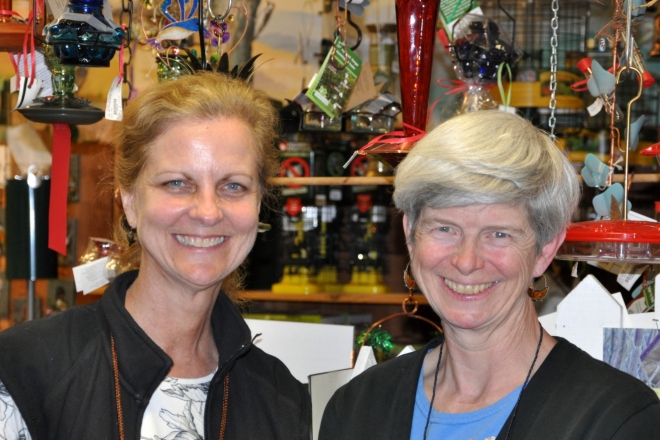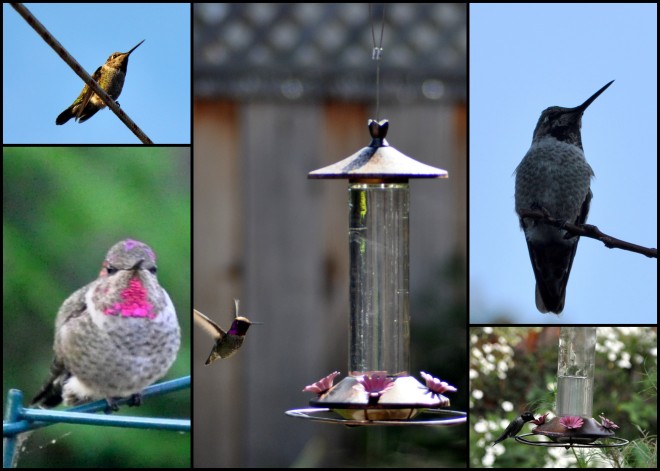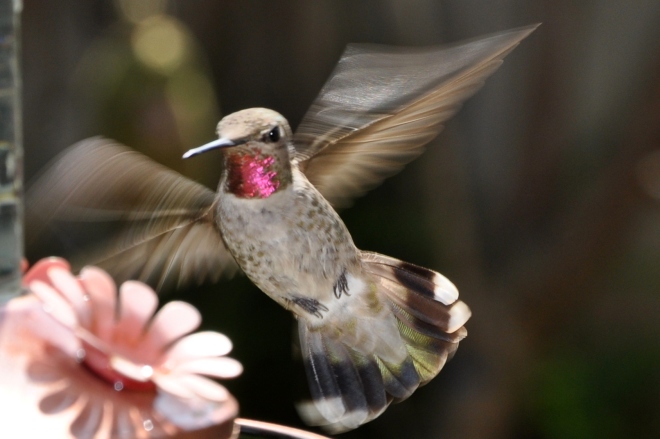Don’t you just love learning new things? It’s especially fun when it’s something your passionate about. We took a hummingbird class at the spectacular Los Gatos Birdwatcher. This locally owned store describes themselves as
the nature lover’s general store, specializing in everything to do with bird feeding and bird watching.
If you’re local, or planning a visit to the area, it’s a must see. The owners and staff are wonderful people, knowledgeable and helpful in every way. Their current dog in residence is a chocolate Cocker spaniel named Marley.
Lisa Myers of Let’s Go Birding presented the hummingbird class, then lead us on a two-hour field trip Saturday morning. We had so much fun. Lisa leads a variety of birding trips throughout the bay area. She’s incredibly knowledgeable with a wonderful sense of humour.
We’ve been feeding hummingbirds in our garden for as long as I can remember. We have several feeders and hummingbird-attracting plants.
I’ve read a number of books and articles over the years, but still found much to learn. It’s also nice spending time with a group of like-minded folks.
Here are a few things I didn’t know:
- There are over 300 species of hummingbirds, but only six or seven in the Bay Area.
- Hummingbirds are native to the Americas. They’re not found anywhere else in the world.
- Yellow attracts bees, red attracts hummingbirds. Therefore a hummingbird feeder with yellow plastic ‘flowers’ sends out mixed messages.
- Anna’s Hummingbirds, native to our area, live here year round. There is no need to remove feeders during the colder months.
- Hummingbirds are the only bird that can hover in the air, as well as fly forward and backward.
It was fascinating learning about torpor. Hummingbirds enter this state of hibernation nightly to conserve energy. I found the following explanation at ScienceBlogs™
Even sleeping hummingbirds have huge metabolic demands that must be met simply to survive the night when they cannot forage. To meet this energetic challenge, hummingbirds save enough energy to survive cold nights by lowering their internal thermostat at night, becoming hypothermic. This reduced physiological state is an evolutionary adaptation that is referred to as torpor.
Torpor is a type of deep sleep where an animal lowers its metabolic rate by as much as 95%. By doing so, a torpid hummingbird consumes up to 50 times less energy when torpid than when awake. This lowered metabolic rate also causes a cooled body temperature. A hummingbird’s night time body temperature is maintained at a hypothermic threshold that is barely sufficient to maintain life. This threshold is known as their set point and it is far below the normal daytime body temperature of 104°F or 40°C recorded for other similarly sized birds.
Isn’t that interesting?
Please be sure to check back tomorrow for news and pictures from our two-hour field trip to the Santa Clara Valley Audubon Society.
Fabulous resources in Silicon Valley:
- Lisa Myers’ Let’s Go Birding leads tours and workshops.
- Los Gatos Birdwatcher, for all things birding.
- Wild Bird Care Center Quite often, wild birds are ‘over rescued’. This site has many great tips for determining if and when to intervene.




WOW! I never knew any of this information about hummingbirds, but I am so glad you shared this with us! For every hummingbird feeder I have seen, they all have those yellow flowers painted on them – – do we just paint them red?
LikeLike
Thank you, Val!
All of our feeders came with red flowers. There is a brand of feeder that sells replacement flowers in red (and yellow…go figure) found here:
http://www.ebay.com/itm/like/111170458827?lpid=82
I think paint would be dangerous to their tiny system, so would suggest replacing the feeder entirely or replacing the flower if possible. The yellow flowers will continue to attract bees which are also good for the garden, so it is just a matter of who gets what at the feeder. We like to encourage and welcome both to our garden as I’m sure you do too. The bees are so happy in the pumpkin patch each summer, and they also really love the sage.
Now if I could just find an opossum to come snack on all those unwelcome snails, the eco-system out back would be a well-oiled machine. 🙂
LikeLike
I am actually going to send you some of my flower seeds that I saved from my flowers for your flower garden! I just need to grab some time to get them wrapped up to send to you. I am dealing with issues of my Mom who is terminal and all the family issues that go along with that right now. I am just numb from all of this.
LikeLike
Oh Val. I’m so sorry to hear this news. I’ve been there and I understand how emotionally difficult it can be. Sending love and strength.
Meanwhile, tremendous appreciation for thinking of me. That is so sweet of you. xox
LikeLike
You always will have a special place in my ❤
LikeLike
That is so sweet. Thank you. xox
LikeLike
That is amazing – sounds like what some creatures do to hibernate in winter. Dormice for example lower their body temperature to just 5°C and reduce their heartbeat from 300 to 5 beats a minute! I hope I will get to see a hummingbird one day. 😀
LikeLike
Hi Cathy,
Yes, it is very much like that. I had never heard of it happening each night during cold weather. In the photos I’ve seen, they do it hanging upside down like a bat. Fascinating.
I hope you see a hummingbird one day, too. We are fortunate to see them daily.
LikeLike
They certainly look like welcoming kind of gals. I’m impressed that you’d still take a class even while your feeders are busy busy. Good for you Alys, it IS fun learning new things. The fuchsia colouring on the chest of the one Hummer is so pretty. Do you think it’s a male? They’re usually the show-offs in nature 🙂
It’s stunning that most cheap feeders sold have yellow flowers and a red base…you see them everywhere. I myself have had several over the years. They don’t seem to last long before they start dripping. Then it’s a wasp attraction. I’m going to pop into my local bird store soon to find myself a good one. Great share Alys, thank you! xoK
LikeLike
Thank you, Boomdee. The bird stores will usually have the highest quality feeders. We bought two of ours at the Los Gatos Birdwatcher, and found the pretty green bottle one at a pet food store on year as a Father’s Day gift for Mike.
Yes, the males are always the handsome devils. We also learned that Hummingbirds are the only birds with iridescent coloring. The immature birds and the females have plain markings and the males shine, quite literally, when the sun hits just right. Thanks for reading and commenting. xo
LikeLike
That’s a lot of wonderful information on humming birds. We had so many on the mountain and I see so few here. I got out the feeders my son gave me for mothers day a few years back but have on read good place to hang them. They are copper and not sure how practical they will be. Still giving it some thought. Thanks for taking us along on your class.. Hugs,M
LikeLike
Thanks, Marlene.
I hope you will find a place to hang your feeder. It is such a joy seeing them fly in for a meal.
Is there a place to put a hook (or perhaps an existing hook) up high on your patio? If not, I hope you land in your new home soon and can start feeding them there.
Hugs to you xox
LikeLike
Loved this post; thanks for sharing!
LikeLike
Thank you for reading!
LikeLike
Fascinating stuff as always!
LikeLike
Thanks, Sharon.
LikeLiked by 1 person
Fascinating! Did not know those facts either. Sounds like a great class!
LikeLike
🙂
LikeLike